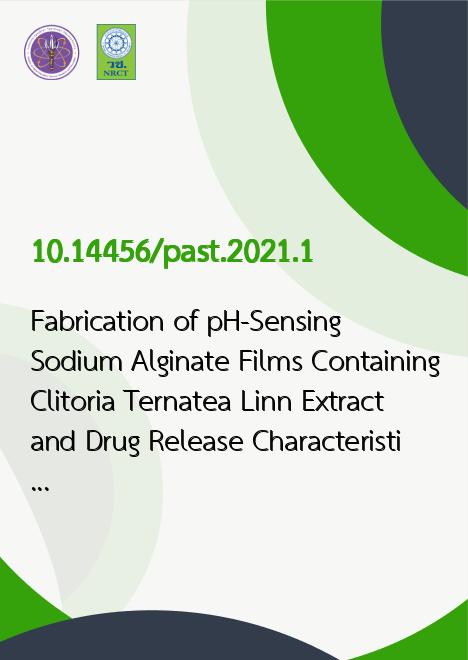
|
Fabrication of pH-Sensing Sodium Alginate Films Containing Clitoria Ternatea Linn. Extract and Drug Release Characteristics |
|---|---|
| รหัสดีโอไอ | |
| Creator | Patcharaporn Wutticharoenmongkol |
| Title | Fabrication of pH-Sensing Sodium Alginate Films Containing Clitoria Ternatea Linn. Extract and Drug Release Characteristics |
| Contributor | Setthawut Sitthisan, Yanisa Kingkaew |
| Publisher | Faculty of Science and Technology, Rajamangala University of Technology Thanyaburi |
| Publication Year | 2564 |
| Journal Title | Progress in Applied Science and Technology |
| Journal Vol. | 11 |
| Journal No. | 1 |
| Page no. | 38-45 |
| Keyword | Alginate, Clitoria ternatea Linn., Drug release, Gallic acid |
| URL Website | https://ph02.tci-thaijo.org/index.php/past/index |
| Website title | Progress in Applied Science and Technology |
| ISSN | 2730-3020 |
| Abstract | Halochromic property of the sodium alginate films containing Clitoria ternatea Linn. flower extract (SA/CT) was studied. Gallic acid (GA) with pKa of 4.4 and resorcinol (RC) with pKa of 9.3 as the model drugs were loaded into the SA/CT films, and their halochromic behaviors were investigated. The color change of the films was influent by the pH of solutions and pKa of drugs. The release profiles of either GA or RC from the films were determined by the total immersion and transdermal diffusion through pig skin method at 37?C for 24 h in three types of media, including an acetate buffer (pH 5), a phosphate buffer (pH 7), and a borax buffer (pH 9) solutions. For the total immersion method, the burst release of drugs at the initial time of release followed by the gradual release until reaching a plateau was observed. The maximum cumulative amounts of drug release were in a range of about 17-29%. The amounts of drug release depended on the pH of the solutions and the pKa of drugs. The more polar molecules exhibited higher amounts of drug release. The slower release and the lower maximum cumulative amounts of drug release in a range of 5-21% were obtained for the transdermal diffusion method. Like the total immersion method, the amounts of drug release depended on the solutions' pH and the pKa of drugs. However, the less polar molecules exhibited higher amounts of drug release. |
